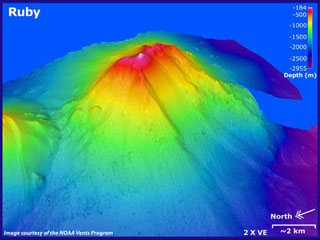Report on Ruby (United States) — October 2023
Bulletin of the Global Volcanism Network, vol. 48, no. 10 (October 2023)
Managing Editor: Benjamin Andrews.
Edited by Kadie L. Bennis.
Ruby (United States) Submarine eruption during 14-16 September 2023
Please cite this report as:
Global Volcanism Program, 2023. Report on Ruby (United States) (Bennis, K.L., and Andrews, B., eds.). Bulletin of the Global Volcanism Network, 48:10. Smithsonian Institution.
Ruby
United States
15.605°N, 145.572°E; summit elev. -174 m
All times are local (unless otherwise noted)
Ruby is a submarine volcano that rises to a depth of about 230 m and is located near the S end of the Mariana arc NW of Saipan. Sonar observations detected an eruption was detected in 1966. In 1995, submarine explosions were heard by fishermen, accompanied by a fish kill, sulfurous odors, bubbling water, and volcanic tremor (BGVN 20:10). This report covers a new eruption during September 2023 characterized by seismoacoustic signals and a discolored submarine plume based on reports from the United States Geological Survey (USGS).
During 14-15 September, seismoacoustic signals were detected and a submarine plume was observed in satellite imagery. Volcanic tremor was first observed on a seismometer around 1900 on 14 September. The USGS reported that another signal followed the tremor at 0016 on 15 September, which represented the start of the eruption. A submarine plume of discolored water was visible in geostationary satellite imagery starting around 0416 on 15 September. The discolored plume was also visible at 0650. Seismicity gradually increased throughout the day, peaking around 1426 with a M 4.7 earthquake. An analysis of seismoacoustic data from a geophysical monitoring station on Saipan (50 km SE) showed eruption signals beginning at 1427 on 15 September; the activity was also detected on other regional geophysical monitoring networks in the Pacific. Later in the day on 15 September, the submarine plume had notably weakened and became greener in color and narrower before detaching from the source vent at 1330 on 16 September. Local observers also reported seeing the plume of discolored water. Based on visuals in satellite images, and no additional activity was recorded by geophysical networks after 16 September; no gas-and-steam emissions were detected in satellite data associated with the eruption or in the following days. The Volcano Alert Level (VAL) was raised to Advisory (the second level on a four-level scale) and the Aviation Color Code (ACC) was raised to Yellow (the second level on a four-color scale) on 19 September. In a report issued on 20 September, USGS reported that there was no evidence of further activity detected in regional seismic and infrasound data. The discolored water plume had drifted slowly E and was still visible in satellite imagery in the ocean between Saipan and Anatahan through 25 September; during 21-23 September the discolored plume was visible in satellite imagery N and NNE of Saipan.
On 6 October the ACC and VAL were lowered to Unassigned, noting that eruptive activity was last detected during 14-15 September. The level of Unassigned reflected the lack of nearby monitoring instruments that could detect low-intensity events.
Geological Summary. Ruby is a basaltic submarine volcano that rises to within about 200 m of the ocean surface near the southern end of the Mariana arc NW of Saipan. An eruption was detected in 1966 by sonar signals (Norris and Johnson, 1969). Submarine explosions were heard in 1995, accompanied by a fish kill, sulfurous odors, bubbling water, and the detection of volcanic tremor.
Information Contacts: US Geological Survey, Volcano Hazards Program (USGS-VHP), 12201 Sunrise Valley Drive, Reston, VA, USA, https://volcanoes.usgs.gov/index.html.

